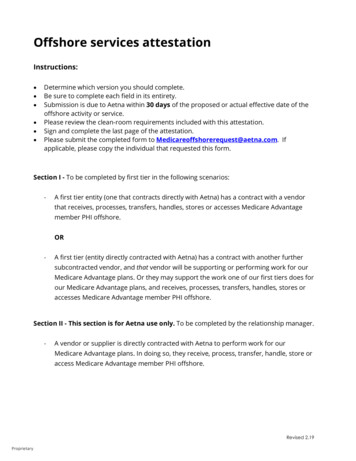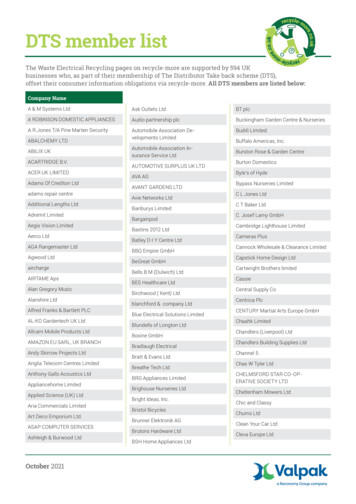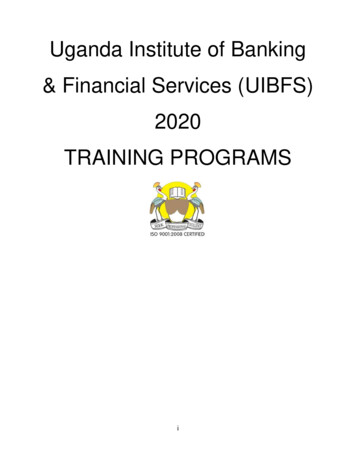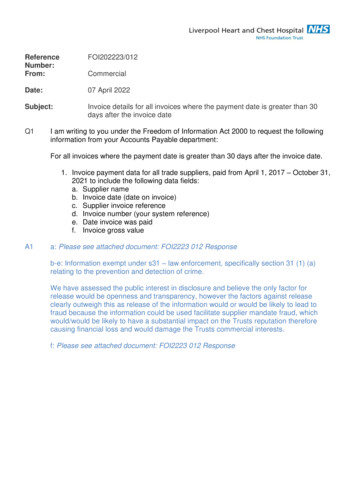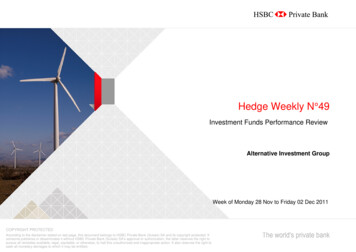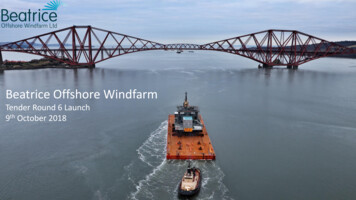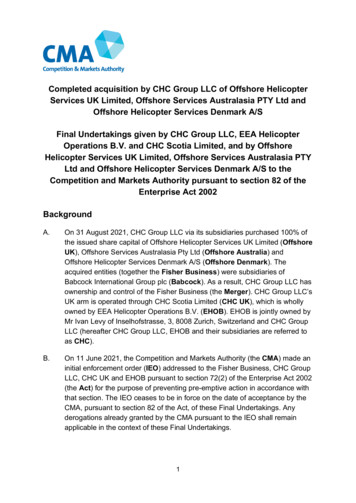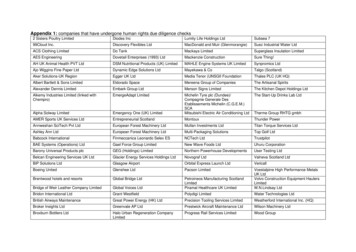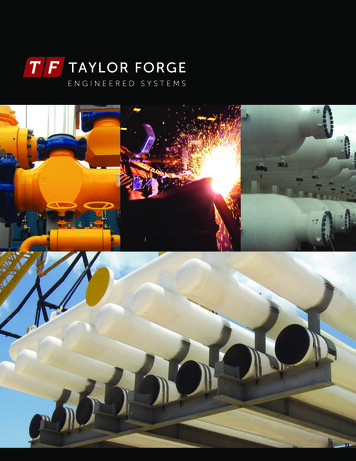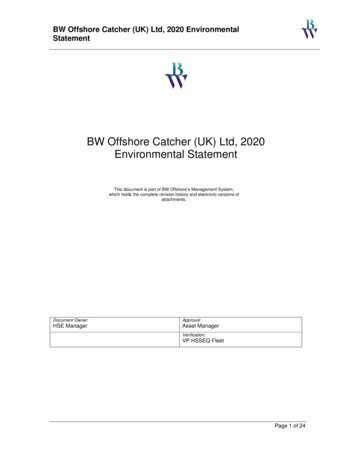
Transcription
BW Offshore Catcher (UK) Ltd, 2020 EnvironmentalStatementBW Offshore Catcher (UK) Ltd, 2020Environmental StatementThis document is part of BW Offshore’s Management System,which holds the complete revision history and electronic versions ofattachments.Document Owner:Approval:HSE ManagerAsset ManagerVerification:VP HSSEQ FleetPage 1 of 24
BW Offshore Catcher (UK) Ltd, 2020 EnvironmentalStatementTable of ContentsABBREVIATIONS31 Introduction51.1Purpose . 52 Overview of Operations63 BW HSE Policy UK94 Environmental Performance114.1Oil in Produced Water . 114.2Chemical Use and Discharge . 124.3Waste . 184.4Atmospheric Emissions . 185 Incidents225.1Unplanned Release – PON1 . 225.2Regulatory Non-Compliance (NC) . 226 Revision Summary24Figure 2-1: BW Catcher General Location Map . 6Figure 2-2: Catcher Area Development. 7Figure 2-3: Catcher Area Development. 8Figure 3-1: Inputs to BW Catcher MS. 10Figure 3-2: BW Catcher MS Continual Improvement Model. . 10Figure 4-1: Amount of chemical permitted and used during 2020. . 14Figure 4-2: Amount of chemical permitted and used during 2020 (without NAPH23002A andASPH13019A). . 15Figure 4-3: Amount of chemical permitted and discharged in 2020. . 16Figure 4-4: Amount of chemical permitted and used during 2020 (without NAPH23002A andASPH13019A). . 17Figure 4-5: BW Catcher fate of waste. . 18Figure 4-6: BW Catcher Combustion Emissions. . 19Figure 4-7: BW Catcher CO2 combustion emissions. . 20Figure 4-8: BW Catcher flaring amounts. . 21Table 4.1: Produced water discharge in 2020. . 11Table 4.2: Produced water re-injected in 2020. . 12Table 4.3: Chemicals with SUB warnings permitted in 2020. . 13Table 5.1: PON1s submitted during 2020. . 22Table 5.2: Non-compliances submitted during 2020. . 23Page 2 of 24
BW Offshore Catcher (UK) Ltd, 2020 EnvironmentalStatementABBREVIATIONSBEISDepartment of Business, Energy & Industrial StrategyCefasCentre for Environment, Fisheries and Aquaculture ScienceCH4MethaneCHARMChemical Hazard and Risk ManagementCNSCentral North SeaCOCarbon MonoxideCO2Carbon DioxideCRAChemical Risk AssessmentESDEmergency Shut DownETSEmissions Trading SchemeFGLFulmar Gas LineFPSOFloating Production Storage and Offloading VesselFPVFloating Production VesselHSEHealth, Safety and EnvironmentHPHigh PressureISOInternational Standards OrganisationLATLowest Astronomical TideLPLow PressureNCNon ComplianceNOxNitrous OxidesOCNSOffshore Chemical Notification SchemeOCROffshore Chemicals RegulationsODPOil Discharge PermitOPEPsOffshore Pollution Emergency PlansOPREDOffshore Petroleum Regulator for Environment & DecommissioningOIWOil in WaterOSPAROslo Paris Convention for the Protection of the Marine Environment of the NorthEast AtlanticPDNPermitted Discharge NotificationPLOPoses Little or No RiskPLONORPoses Little or No RiskPONPetroleum Operations NoticePPCPollution, Prevention and ControlSEGALShell Esso Gas and Associated LiquidsSEMSSafety and Environmental Management SystemSOxSulphur OxidesPage 3 of 24
BW Offshore Catcher (UK) Ltd, 2020 EnvironmentalStatementSTPSubmerged Turret ProductionSUBChemicals Rated for SubstitutionUKUnited KingdomUKCSUnited Kingdom Continental ShelfVOCVolatile Organic CompoundPage 4 of 24
BW Offshore Catcher (UK) Ltd, 2020 EnvironmentalStatement1 Introduction1.1 PurposeBW Offshore has one legal entity currently operating in the United Kingdom Continental Shelf(UKCS), BW Offshore Catcher (UK) Ltd, hereafter referred to as BWOCUK. BWOCUK is theDuty Holder / Operator of the BW Catcher Floating, Production, Storage and Offloading (FPSO)facility which is currently producing from the Catcher Area Fields (Premier Oil UK are the licenceholder for the Catcher Field Area).Under Recommendation 2003/5 of the Oslo Paris Convention for the Protection of the MarineEnvironment of the North-East Atlantic (OSPAR), the Offshore Petroleum Regulator forEnvironment and Decommissioning (OPRED) requires that all companies operating in the UKCShave systems and procedures in place to identify, monitor and control the environmental aspectsassociated with offshore activities.BW Offshore’s worldwide operations are certified to the international environmental managementsystem standard, ISO 14001. Recertification of the BW Offshore ISO 14001 environmentalmanagement system was concluded in September 2020.Surveillance visits by the BW Offshore verifier are undertaken annually throughout the fleet.This report provides information on BWOCUK’s offshore operations and the environmentalperformance of these operations. For the purpose of this report, this includes all productionactivities in the United Kingdom Continental Shelf (UKCS).This report has been made available on the BW Offshore website.Page 5 of 24
BW Offshore Catcher (UK) Ltd, 2020 EnvironmentalStatement2 Overview of OperationsThe Catcher Area Development is located in Block 28/9 of the central North Sea (CNS) c. 170km southeast of Aberdeen and c. 100 km from the UK/Norway median line in water depths of c.85 m Lowest Astronomical Tide (LAT) (Figure 2-1).The BW Catcher FPSO has been contracted by Premier Oil UK to produce from three fields:Catcher, Varadero and Burgman. The three fields are tied back to the BW Catcher FPSO vessellocated at c. 56 46’12.43” N and 00 42’46.93” E (WGS84) (Figure 2-2). The principal facilitiesinclude subsea facilities and a turret-moored and free weather-vaning FPSO.The FPSO is capable of processing up to 66,000 bbls of oil per day and has a maximum cargostorage capacity of 650,000 bbls. Therefore, at maximum capacity the FPSO offloads theprocessed crude oil to a shuttle tanker approximately once every 8 days. When offloading cargo,tank blanketing will normally use low pressure (LP) fuel gas, with this gas being recovered viathe flare gas recovery package during filling of the cargo tanks between offloads. Initially,produced gas will be used for power generation and gas lift, with excess being exported into theShell Esso Gas and Associated Liquids (SEGAL) system (Fulmar Gas Line (FGL) to St Fergusgas pipeline).In normal operations, BW Catcher flaring will be restricted to high pressure (HP) flare purge gasonly. The LP flare system includes a Vapour Recovery Package to recover purges and ventssent to the LP flare system. The LP flare will be lit, as required, in process upset or ESDconditions only. Produced water will be treated and then either re-injected or discharged underan Oil Discharge Permit (ODP) issued by BEIS.Figure 2-1: BW Catcher General Location MapPage 6 of 24
BW Offshore Catcher (UK) Ltd, 2020 Environmental StatementFigure 2-2: Catcher Area DevelopmentPage 7 of 24
BW Offshore Catcher (UK) Ltd, 2020 EnvironmentalStatementThe BW Catcher FPSO in field commissioning activities commenced following hook up inOctober 2017. The FPSO achieved First Oil on the 23rd December 2017. An interim performancetest was successfully completed on the 6th January 2018. Client final acceptance performancetest following commissioning was achieved in July 2018 with final acceptance certificate beingissued in November 2018.Gas lift has been commissioned on the Catcher, Burgman and Varadero production wells,including the wells of Varadero Template 2 which were drilled during 2020. Subsea tie-in ofVaradero Template 2 was completed and commissioned in September 2020.An additional drill centre, Catcher North/ Laverda (CN/L), was installed during the same subseacampaign and has pipeline tiebacks to the Varadero Bundle. CN/L drilling is yet to be completed.Completion and commissioning of CN/L wells is expected in 2022. Figure 2-3 provides fieldlayout drawing of the Catcher Field Area with the CN/L facilities.Figure 2-3: Catcher Area Development.Page 8 of 24
BW Offshore Catcher (UK) Ltd, 2020 EnvironmentalStatement3 BW HSE Policy UKBW Offshore is focused on protecting the environment in line with our stated commitment toreduce our impact to a level that is as low as reasonably practicable. This involves ongoingassessment, monitoring and reporting on environmental impacts.The BW Offshore Management System (MS) exists to provide a systematic approach to themanagement of Health, Safety and Environment (HSE) issues in order to protect people and theenvironment and comply with UK legislation. The BW Offshore MS takes on the same purposeas a Safety and Environmental Management System (SEMS) as described within Safety CaseRegulations.BW Offshore considers that HSE have equal status with other primary business objectives andare of strategic importance. Safe working practices and due consideration of environmentalimpact are vital to the overall efficiency and continued success of the business. The HSE policyforms the basis for the MS and is presented below.The MS meets the requirements of The Offshore Installations (Offshore Safety Directive) (SafetyCase) Regulations 2015 and Offshore Installations (Safety Case) Regulations 2005, in particularthe contents of Schedules 2 and 3.The SEMS requirements are met by using the existing processes and procedures containedwithin the BW Offshore Integrated Management System, and supplementing with processes andprocedures specific to the operations of BWOCUK in the UKCS (Figure 3-1).Page 9 of 24
BW Offshore Catcher (UK) Ltd, 2020 EnvironmentalStatementFigure 3-1: Inputs to BW Catcher MS.The purpose of the MS is to provide a framework for the management of all hazards andassociated risks generated through the operation of the BW Catcher FPSO.The basic principal applied within the MS is one of continual improvement in the management ofrisk, both environmental and health and safety related. In order to achieve this the MS utilisesthe Plan, Do, Check and Act modelFigure 3-2).Figure 3-2: BW Catcher MS Continual Improvement Model.Page 10 of 24
BW Offshore Catcher (UK) Ltd, 2020 EnvironmentalStatement4 Environmental PerformanceEnvironmental performance 2020 for the BW Catcher FPSO is detailed in the following subsections.4.1 Oil in Produced WaterDuring normal production, water is produced when extracting hydrocarbons from the reservoir.Despite treatment, produced water still contains traces of oil, and as such, produced waterdischarge is controlled via a permitting system managed by the UK regulatory authority, OPRED.The 2020 Oil Discharge Permit (OLP/570) held by BWOCUK allows the BW Catcher FPSO todischarge produced water, provided the hydrocarbon concentration is within the limit set out inthe permit.The amount of produced water discharged in 2020 is outlined in Table 4.1.JanuaryProduced water discharged(m3)12,199.00Days onstream6Average OiW(mg/L)8.68Oil ber0.0000.000.000022,282.2013-0.2860TotalTable 4.1: Produced water discharge in 2020.BW Catcher FPSO was permitted to discharge a total of 321,999.1 m3 of produced water during2020 however the actual volume of produced water discharged to sea during 2020 was22,282.20 m3. The average concentration of oil discharged in produced water was 12.84 mg/Lsignificantly below the permitted OIW average of 25 mg/L.BWOCUK utilises a produced water re-injection system which when online injects a portion orthe full amount of the produced water back into the reservoir as opposed to discharging itoverboard.Table 4.2 overleaf outlines the amount of produced water re-injected during 2020.Page 11 of 24
BW Offshore Catcher (UK) Ltd, 2020 EnvironmentalStatementMonthJanuaryProduced water re-injected(m3)23,348.7014Average OiW(mg/L)10.04Days on 33Total1,281,685.40253Table 4.2: Produced water re-injected in 2020.-4.2 Chemical Use and DischargeVarious chemicals are used offshore during production operations.During production operations, chemicals such as scale dissolvers, corrosion inhibitors,demulsifiers and biocides are used to assist with the separation of oil and water, prevent damageto infrastructure such as pipelines, and to prevent ‘souring’ of the reservoir.Any chemical used to process hydrocarbons offshore must, in line with the Offshore ChemicalRegulations 2002 (as amended), be registered by the Centre for Environment, Fisheries andAquatic Sciences (Cefas). The chemicals are subject to robust environmental risk assessmentand once registered, their use is controlled and monitored through a permit granted by OPRED.Under the Offshore Chemical Notification Scheme (OCNS), chemicals are ranked according tothe assessed hazard to the environment and are given a lettered heading E, D, C, B or A, with Erepresenting the lowest and A the highest hazard category.Using the Chemical Hazard and Risk Management (CHARM) model, a colouring band is used toshow which chemicals pose the highest environmental hazard. These bands are Gold, Silver,White, Blue, Orange or Purple with Gold representing the lowest hazard and Purple the highest.Some chemicals are regarded as PLONOR (PLO), which means that they have been determinedto Pose Little Or NO Risk to the environment.Any chemicals that carry substitution (SUB) warnings or which pose a risk to the marineenvironment (determined using criteria from the OPRED) have been justified in the ChemicalRisk Assessment (CRA) document that accompanies the production permit.BW Offshore, it’s contractors and chemical suppliers work on a continuous basis to find suitablealternatives to replace the products with SUB warnings.Page 12 of 24
BW Offshore Catcher (UK) Ltd, 2020 EnvironmentalStatement4.2.1BW Catcher Chemical Use and Discharge 2020Four chemicals with substitution warnings (SUB) were permitted for use on BW Catcher in 2020,and these are detailed in Table 4.3.Chemical nameCORR11389ASupplierChampionX (ChampionTechnologies Ltd)StatusUsed anddischargedReplacement statusNot replacedThis chemical is no longerrequired and was neverused.This chemistry will alwaysrequire a heavy metalChampionX (ChampionUsed andcatalyst and will thereforeOSCV20016ATechnologies Ltd)dischargedalways have a subwarning due to the toxicitylevelThis application willUsed andalways require this type ofPHASETREAT 6173Clariant Oil Services UK Ltddischargedchemistry which has aSUB warning.Table 4.3: Chemicals with SUB warnings permitted in 2020.NAPH22001AChampionX (ChampionTechnologies Ltd)Not used ordischargedA total of 42 chemicals were permitted for use, with 26 being used and discharged on BW Catcherduring 2020. These uses are representative of chemical use quantities required to processhydrocarbons that are produced at BW Catcher.2,755,798 kg of chemicals were used during 2020 and of that 267,181 kg was discharged duringoperations in 2020.Figure 4-1 shows the amount of chemicals permitted for use and used during 2020, howeverdue to the scale of use for two of the chemicals, they have been removed from Figure 4-2 inorder to view the other chemicals in greater detail.Figure 4-3 shows the amount of chemicals permitted for discharge and discharged during 2020,however due to the scale of use for two of the chemicals, they have been removed from Figure4-4 in order to view the other chemicals in greater detail.Page 13 of 24
BW Offshore Catcher (UK) Ltd, 2020 Environmental StatementFigure 4-1: Amount of chemical permitted and used during 2020.Page 14 of 24
BW Offshore Catcher (UK) Ltd, 2020 Environmental StatementFigure 4-2: Amount of chemical permitted and used during 2020 (without NAPH23002A and ASPH13019A).Page 15 of 24
BW Offshore Catcher (UK) Ltd, 2020 Environmental StatementFigure 4-3: Amount of chemical permitted and discharged in 2020.Page 16 of 24
BW Offshore Catcher (UK) Ltd, 2020 Environmental StatementFigure 4-4: Amount of chemical permitted and used during 2020 (without NAPH23002A and ASPH13019A).Page 17 of 24
BW Offshore Catcher (UK) Ltd, 2020 EnvironmentalStatement4.3 WasteWaste is generated from offshore operations and is transported onshore for re-use, recycling,treatment or disposal.Production installation waste is segregated into categories before back-loading. As much wasteas possible is sent for recycling. This includes wood, scrap metals, paper/cardboard, glass andplastics.Waste that cannot be recycled is sent to landfill. Certain types of waste that are harmful to theenvironment (Special Waste) are sent ashore to be processed and disposed of by licensedhandlers in accordance with the relevant legislation.BW Offshore target areas where the amount of waste generated can be further reduced. On theBW Catcher FPSO, E-reps have been established and are actively involved in continuousawareness raising, monitoring and reduction of waste initiatives.4.3.1BW Catcher FPSO Waste 2020A total of 354 tonnes of waste was disposed of from the BW Catcher FPSO in 2020 via the wastemanagement contract. Of the total waste produced, 55.66% was recycled, 9.79% was waste toenergy, 0.28% was incinerated and 16.50% was landfilled (Figure 4-5).Figure 4-5: BW Catcher fate of waste.4.4 Atmospheric EmissionsAtmospheric emissions arise during offshore drilling and production operations predominantly asa result of fuel combustion for power generation and gas flaring activities.Page 18 of 24
BW Offshore Catcher (UK) Ltd, 2020 EnvironmentalStatement4.4.1BW Catcher Atmospheric Emissions 2020The BW Catcher FPSO is regulated under the Pollution, Prevention and Control (PPC)Regulations as a large combustion installation. As such, the installation has set limits onatmospheric emissions of nitrous oxides (NOx), sulphur oxides (SOx), carbon monoxide (CO),methane (CH4) and volatile organic compounds (VOCs).Figure 4-6 shows the combustion emissions (excluding CO2) for 2020. All emissions were withinlimits set by BEIS in the BW Catcher PPC Permit.Figure 4-6: BW Catcher Combustion Emissions.BW Catcher FPSO is also regulated under the United Kingdom Emission Trading Scheme (UKETS) Regulations, which regulate CO2 emissions for combustion sources, such as turbines andgenerators.During 2020, 122,601.47 tonnes of CO2 were emitted from combustion activities on BW CatcherFPSO. During normal operations, BW Catcher FPSO runs with two turbines on and as can beseen in Figure 4-7 the primary source of fuel is from fuel gas (all produced gas would be usedas fuel with excess gas being exported), however the turbines can also run on diesel.Page 19 of 24
BW Offshore Catcher (UK) Ltd, 2020 Environmental StatementFigure 4-7: BW Catcher CO2 combustion emissions.Page 20 of 24
BW Offshore Catcher (UK) Ltd, 2020 Environmental Statement4.4.2FlaringThe cumulative flaring amount for 2020 was 6,908.52 tonnes, which is below the permitted amount of 11,916 tonnes. This is displayed in Figure 4-8.Figure 4-8: BW Catcher flaring amounts.Page 21 of 24
BW Offshore Catcher (UK) Ltd, 2020 EnvironmentalStatement5 IncidentsBWOCUK strive to prevent the unplanned release of hydrocarbons and chemicals, however, onoccasion accidental releases do occur. All unplanned releases of hydrocarbons and chemicalsto sea from offshore oil and gas installations and pipelines, regardless of size, are reported toOPRED and other statutory agencies via the Petroleum Operations Notice 1 (PON1) form.Permitted Discharge Notifications (PDN’s) are also submitted using PON 1 forms when permitteddischarges are in breach of conditions / limits associated with the installations Oil DischargePermit.A number of processes are in place to prevent unplanned releases and these include plannedmaintenance of equipment, asset integrity inspections, activity risk assessment, areainspections, routine audits, procedural controls and training and competency for individualsinteracting with process plant. Oil Pollution Emergency Plans (OPEPs) approved by OPRED arein place covering the installation. The plan is exercised on a regular basis and followed in theevent that an unplanned release does occur, to ensure that the incident is reported in a timelyfashion and that contingency and mitigation measures are in place.5.1 Unplanned Release – PON1During 2020, one PON1 was submitted to the regulator for an unplanned release from BWCatcher FPSO, outlined in Table 5.1 below.Name/ DescriptionRegulatortrackingnumberRelease TypeOverflow of Hazardous openPON1/9276Oily waterdrain tank resulting in minorspill of oily fluid to seaTable 5.1: PON1s submitted during .2 Regulatory Non-Compliance (NC)Three non-compliances were raised in relation to permit condition breaches, as described inTable 5.2 overleaf.Page 22 of 24
BW Offshore Catcher (UK) Ltd, 2020 EnvironmentalStatementName/ DescriptionOCR Non-compliance - Use ofAcetic Acid at injection pointthat was not described on thepermit.OPPC NC - OIW 100mg/l(192mg/l)OLP Non-Compliance - Failureto submit OPPC MonthlyReturnRegulator trackingnumberRelease 306N/AN/AClosedTable 5.2: Non-compliances submitted during 2020.Page 23 of 24
BW Offshore Catcher (UK) Ltd, 2020 EnvironmentalStatement6 Revision SummaryRev.DateDocument owner to summarise key changes in the documentA28/05/2021Issued for Review0028/05/2021Issued for UsePage 24 of 24
SEGAL Shell Esso Gas and Associated Liquids SEMS Safety and Environmental Management System SO x Sulphur Oxides . BW Offshore Catcher (UK) Ltd, 2020 Environmental . Surveillance visits by the BW Offshore verifier are undertaken annually throughout the fleet. This report provides information on BWOCUK's offshore operations and the .
